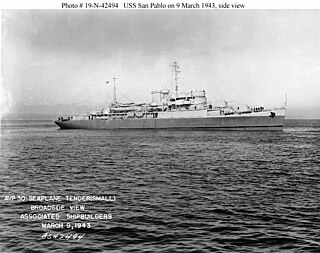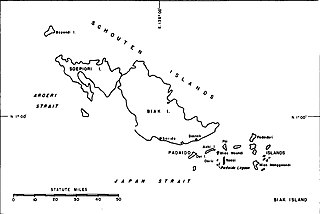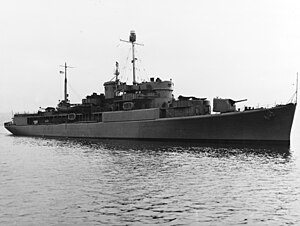
Seeadler Harbor, also known as Port Seeadler, is located on Manus Island, Admiralty Islands, Papua New Guinea and played an important role in World War II. In German, "Seeadler" means sea eagle, pointing to German colonial activity between 1884 and 1919 in that area. The bay was named in 1900 after the German cruiser SMS Seeadler.

The second USS Mackinac (AVP-13) was a United States Navy Barnegat-class small seaplane tender in commission from 1942 to 1947 that saw service during World War II. After the war, she was in commission in the United States Coast Guard from 1949 to 1967 as the cutter USCGC Mackinac (WAVP-371), later WHEC-371, the second ship of the Coast Guard or its predecessor, the United States Revenue Cutter Service, to bear the name.

USS San Pablo (AVP-30) was a United States Navy Barnegat-class seaplane tender which was in commission as such from 1943 to 1947 and then served as a commissioned hydrographic survey ship, redesignated AGS-30, from 1948 to 1969. Thus far, she has been the only ship of the United States Navy to be named for San Pablo Bay, a shallow northern extension of San Francisco Bay in California.

The third USS Casco (AVP-12) was a United States Navy Barnegat-class small seaplane tender in commission from 1941 to 1947. She saw service in World War II. After her decommissioning, the U.S. Navy loaned her to the United States Coast Guard, in which she served as the cutter USCGC Casco (WAVP-370), later WHEC-370, from 1949 to 1969.

USS Hilo (AGP-2) was a converted yacht that saw service as a motor torpedo boat tender in the United States Navy during World War II. It was originally the yacht Caroline built for Eldridge R. Johnson and launched 18 July 1931. Caroline was at the time the second largest yacht and largest American built Diesel yacht. It was built with a laboratory as well as palatial quarters and was loaned and equipped by Johnson for the Johnson-Smithsonian Deep-Sea Expedition of 1933 that explored the Puerto Rico Trench. The yacht was sold in 1938 to William B. Leeds and renamed Moana replacing an earlier Leeds yacht of the same name.

USS Jamestown (PG-55) was a patrol gunboat and after 13 January 1943 a Jamestown-class motor torpedo boat tender acquired by the U.S. Navy during World War II. Her task in her final classification was to provide a "home base" for torpedo boats in remote parts of the ocean during the war, and to provide them with necessary services, such as fuel, food, and repairs.
USS Portunus (AGP-4) was an LST-1-class tank landing ship acquired by the U.S. Navy for use during World War II as a motor torpedo boat (MTB) tender. She was named after a Roman god of the sea, who had jurisdiction over ports and the shores.

Mios Woendi island is an island in the Schouten Islands of Papua province, eastern Indonesia. It lies in Cenderawasih Bay 50 kilometres off the northwestern coast of the island nation of Papua New Guinea.

USS San Carlos (AVP-51) was a Barnegat-class seaplane tender built for the United States Navy during World War II. San Carlos, named after San Carlos Bay, Florida, was in commissioned from 1944 to 1947 and earned three battle stars for service in the Pacific during World War II. After eleven years in reserve, San Carlos was converted to oceanographic research ship USNS Josiah Willard Gibbs (T-AGOR-1)—named after American scientist Josiah Willard Gibbs—and placed in service as a non-commissioned ship of the Military Sea Transportation Service from 1958 to 1971. In December 1971, the ship was transferred to the Hellenic Navy as Hephaistos (A413), a motor torpedo boat tender. Hephaistos was struck from the rolls of the Hellenic Navy in April 1976.

USS Wachapreague (AGP-8) was a motor torpedo boat tender in commission in the United States Navy from 1944 to 1946, seeing service in the latter part of World War II. After her Navy decommissioning, she was in commission in the United States Coast Guard from 1946 to 1972 as the cutter USCGC McCulloch (WAVP-386), later WHEC-386, the fourth ship of the U.S. Coast Guard or its predecessor, the United States Revenue Cutter Service, to bear the name. In 1972 she was transferred to South Vietnam and served in the Republic of Vietnam Navy as the frigate RVNS Ngô Quyền (HQ-17). Upon the collapse of South Vietnam at the end of the Vietnam War in 1975, she fled to the Philippines, and she served in the Philippine Navy from 1977 to 1985 as the frigate RPSGregorio del Pilar (PF-8) and from 1987 to 1990 as BRP Gregorio del Pilar (PF-12).

The second USS Willoughby (AGP-9) was a motor torpedo boat tender that served in the United States Navy from 1944 to 1946, seeing service in the later stages of World War II. Transferred to the United States Coast Guard in 1946, she was in commission as the cutter USCGC Gresham (WAVP-387), later WHEC-387 and WAGW-387, from 1947 to 1969 and from 1970 to 1973, seeing service in the Vietnam War during her Coast Guard career.

USS Half Moon (AVP-26) was a seaplane tender that in commission in the United States Navy from 1943 to 1946 that saw service in the latter half of World War II. After the war, she was in commission in the United States Coast Guard as the cutter USCGC Half Moon (WAVP-378), later WHEC-378, from 1948 to 1969, seeing service in the Vietnam War during her Coast Guard career.
USS Orestes (AGP-10) was a motor torpedo boat tender that served in the United States Navy from 1944 to 1946.

The second USS Barataria (AVP-33) was a United States Navy Barnegat-class seaplane tender in commission from 1944 to 1946. She saw service in the later stages of World War II and was decommissioned postwar. She then was transferred to the United States Coast Guard and was in commission as the Coast Guard cutter USCGC Barataria (WAVP-381), later WHEC-381 from 1949 to 1969, serving in the Cuban Missile Crisis and the Vietnam War during her lengthy Coast Guard career.

The Barnegat class was a large class of United States Navy small seaplane tenders (AVP) built during World War II. Thirty were completed as seaplane tenders, four as motor torpedo boat tenders, and one as a catapult training ship.
USS Varuna (AGP-5) was a Portunus-class motor torpedo boat tender of the United States Navy during World War II.

USS Acontius (AGP-12) was a motor torpedo boat tender in service with the United States Navy from 1944 to 1946. She was scrapped in 1965.
PT-143 was a PT-103-class motor torpedo boat of the United States Navy that served during World War II.

Manus Naval Base was a number of bases built after the World War II Battle of Manus by United States Navy on the Manus Island and a smaller island just east, Los Negros Island in the Admiralty Islands chain. The major naval base construction started with the Los Negros landings on February 28, 1944. The Navy repaired and did the expansion of the airfields on the Admiralty Islands. United States Navy Seabee built or repaired the facilities on the islands. The large Manus Naval Base, also called the Admiralty Island base, supported United States Seventh Fleet, Southwest Pacific command, and part of the Pacific Fleet. The base was abandoned by the US Navy after the war.

Naval Base Kossol Roads also called Naval Base Kossol Passage was major United States Navy base at Kossol Roads in northern Palau in the western Caroline Islands in the western Pacific Ocean during World War II. Kossol Roads lagoon is surrounded by fringing coral reef. The base was built to support the island hopping Pacific war efforts of the allied nations fighting the Empire of Japan. In terms of the number of ships at one base, Naval Base Kossol Roads was one of the largest Naval Base in the world in 1944 and 1945. Naval Base Kossol Roads was unique, as it was the only large US Naval base to have no shore facilities. Kossol Roads was part of US Naval Base Carolines.
















